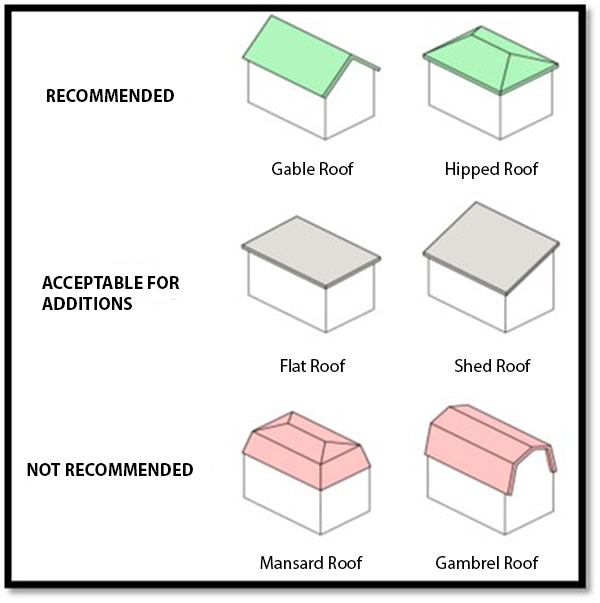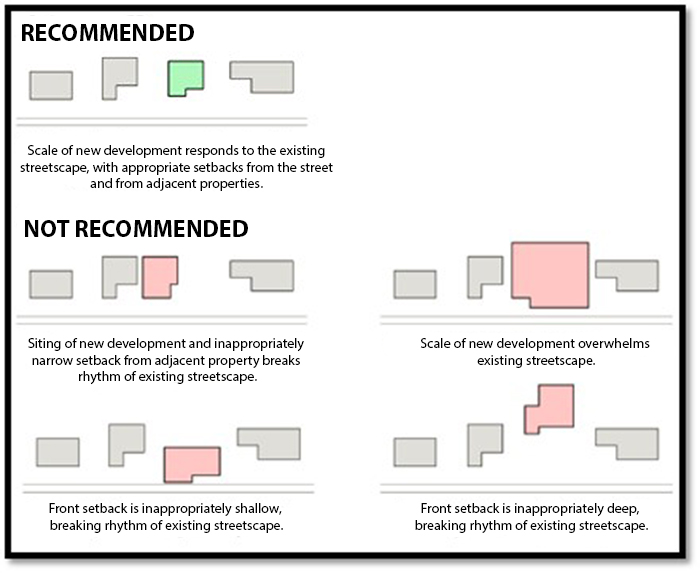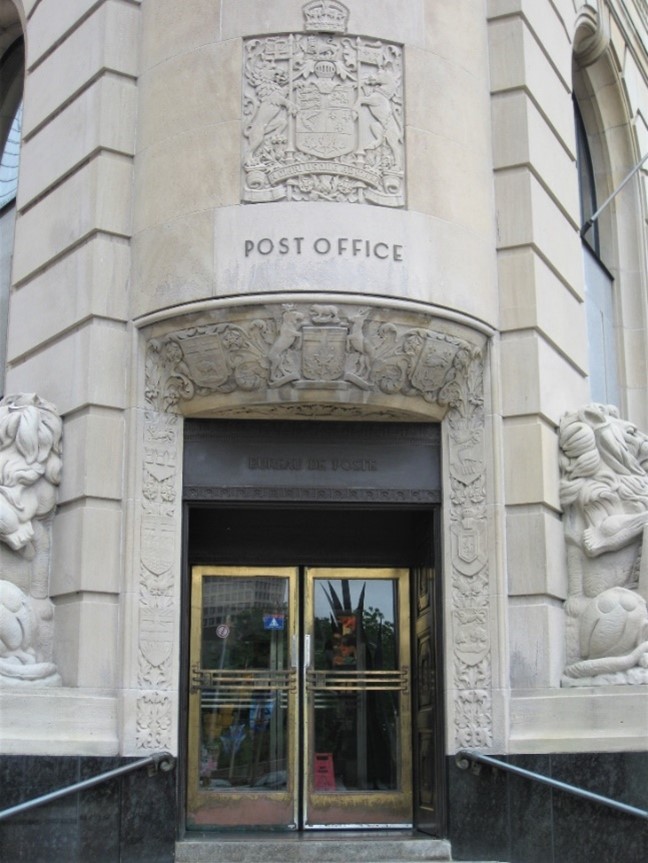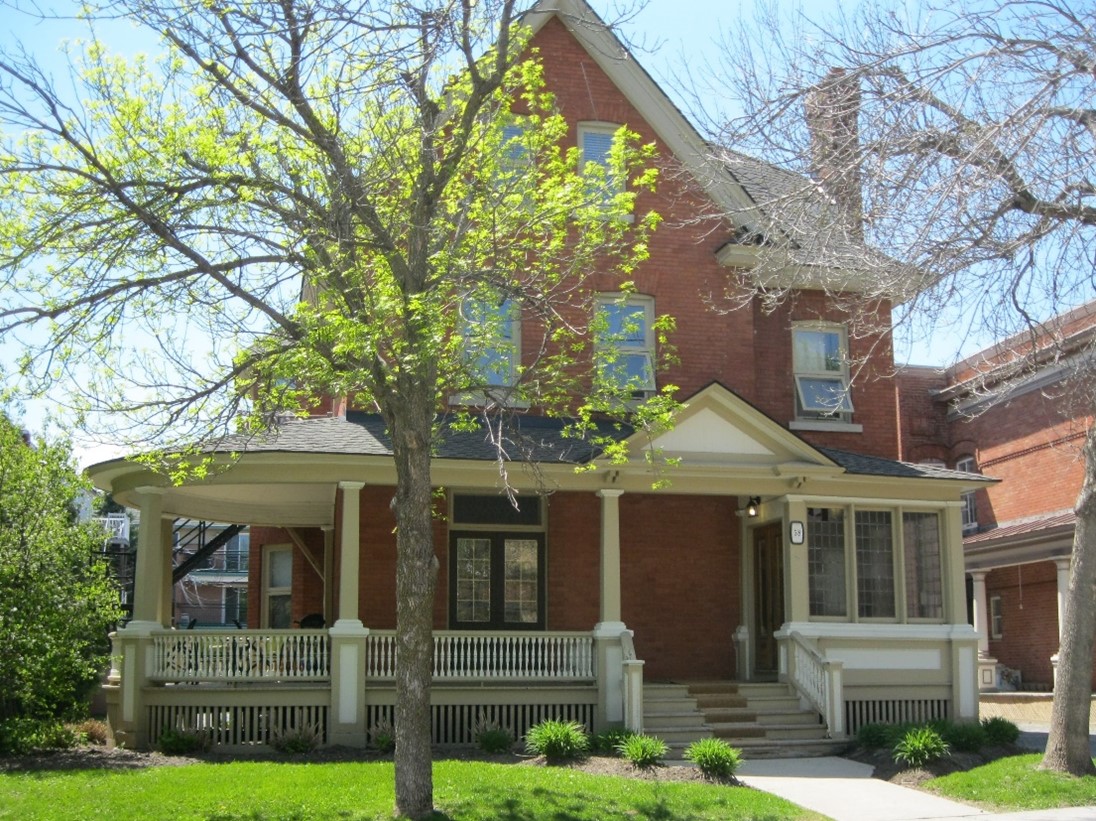3. The heritage conservation district plan
3.1. Step 1 – Preparation of the HCD plan and guidelines
The Ontario Heritage Act requires municipalities to adopt an HCD plan when they pass the bylaw to designate an area as an HCD.
3.1.1. Statement of objectives
An HCD plan must include a statement of the objectives to be achieved in designating the area as a heritage conservation district. The overall objective of an HCD plan is to provide policies and guidelines that will assist in the protection and enhancement of the cultural heritage value of the district. The district and its current condition should be briefly described, as should the community’s goals and aspirations for its future. Once the district plan is adopted, its policies and objectives will take precedence in the event of a conflict with existing municipal zoning and other bylaws that were in place before the designation of the district.
The HCD plan should provide policy statements, guidelines and procedures for achieving the plan’s objectives and managing change. Alterations and new development within a district should be guided by the plan with the intent to both protect and enhance the identified cultural heritage value. The plan should not be created to control or prohibit development but rather as a commitment to take positive action to safeguard and enhance the appearance, character and value of the heritage conservation district.
The objectives may include:
- identify and enhance the vitality and viability of the area
- encourage a sense of place by conserving features that help define character
- develop design guidelines which define appropriate change for new construction and alterations to existing buildings and
- recommend implementation and management procedures.
Summary – Contents of the HCD plan required by the Ontario Heritage Act
- statement of objectives to be achieved in designation of area as an HCD
- statement explaining the cultural heritage value or interest of the district
- description of district’s heritage attributes and those of properties within the district
- policy statements, guidelines and procedures for achieving stated objectives and managing changes in the district
- description of external alterations or classes of external alterations that are of a minor nature that an owner can carry out without obtaining a permit
3.1.2. Statement of district’s cultural heritage value or interest
The statement must explain the cultural heritage value of the district. A clear statement will help to promote understanding of the district’s cultural heritage value and will assist decision-makers in ensuring that future changes and interventions contribute to, rather than detract from, the character of the area. Statements of cultural heritage value or interest must include a statement explaining how the criteria in O. Reg. 9/06 have been met (where applicable). Note that the criteria of at least two or more of the nine criteria listed under section 3 of O. Reg. 9/06 are only required in respect of bylaws passed on or after January 1, 2023 (where notice of public meeting was not provided before January 1, 2023).
3.1.3. Description of heritage attributes
3.1.3.1. Summary of heritage attributes
The description of heritage attributes should include a summary of those components (e.g., buildings, landscape, archaeological and other property features, etc.), that were identified in the evaluation phase. There should be an emphasis on common characteristics plus unusual features or landmarks.
3.1.3.2. Detailed description of heritage attributes
There should also be a more detailed listing and description of the heritage attributes of the district and of the properties within it. It should briefly explain how the heritage attributes contribute to the district’s cultural heritage value or interest. For example, in some districts the architectural detail of building façades is an important contributor.
A detailed description and photographs of the heritage attributes should be provided. Their location should be indicated on a map wherever possible.

- Restored eyebrow dormer windows
- Restored wood shingle roof
- Restored soffit and profiled eave framing
- Restored brickwork
- Restored wood hung sash window with muntins
- Restored ornamental brick band and detailing
- Carved and painted signage (with top lighting, not back lit)
- Restored ornamental capitals and moulding
- Restored storefront glazing with muntins
- Restored wood panel bases
- Recessed entrances
- Plasters divide vertical bays
3.1.4. Policy statements and guidelines
3.1.4.1. Statement of policies
The Ontario Heritage Act requires that a district plan include a statement of policies and guidelines. This is an expression of a municipality’s commitment to consistent decision-making in the review of development proposals and heritage permit applications. They should also reflect the municipality’s proposed program of public works and other work to maintain or enhance the area character.
The policies and guidelines in the district plan should not just focus on individual heritage buildings or areas. Potential impact from new development, traffic access, parking, signage and outdoor advertisements, and required mitigation measures all need to be considered. The district plan may also need to deal with traffic management schemes or incentives for the use of upper floors in older commercial blocks.
3.1.4.2. District guidelines
The HCD plan must include a description of the alterations or classes of alterations that are minor in nature and that property owners within the district may be allowed to carry out on any part of the property, other than the interior of any structure or building on the property, without obtaining a permit under Section 42.

Guidelines for conservation of heritage property and identified heritage resources should be compatible with advice and guidelines of the Ontario government (see Ministry of Citizenship and Multiculturalism website) and the Ontario Heritage Trust. The Standards and Guidelines for the Conservation of Historic Places in Canada, developed by Parks Canada may be a useful reference, but where conflicts exist, the policies and advice issued by the province prevail.
Since guidelines will be used by property owners, as well as municipal planners, councillors and municipal heritage committees, they should be written clearly and simply and should include graphics and visual material that will explain what changes or alterations are appropriate, satisfy policy objectives for enhancing the district, and likely to be approved by council or staff.
In some cases, (e.g., new infill development), there may be alternative ways to comply with the policy objective. The guidelines should indicate clearly what options are available and include recommended development standards, type of materials and quality of detailing required, for development of infill and vacant land.

For districts with a large number of properties a detailed approach to each property may be too cumbersome and impractical. It may be more practical to have more general guidelines that indicate the types of change that will be considered appropriate for existing groups of buildings as well as generic design types for new construction.
On vacant and other potential development sites, the preferred siting, scale, maximum allowable height, setback of new building or additions may need to be specified, as well as the preferred colour, texture and type of materials to be used. Guidelines can also be a useful source of information for general advice on landscape conservation and restoration techniques, tree planting and garden design.
3.1.5. Description of minor alterations
The heritage conservation plan must include a description of external minor alterations or classes of minor alterations that an owner can carry out without obtaining a permit under section 42 of the Ontario Heritage Act. This will help to reduce delay in approval of heritage permit applications and allow property owners to carry out maintenance type work, (e.g., painting and repairs of windows, renewal of a roof, using exact material and colours).
There should be extensive community input before deciding on the type of “minor alterations” that can be carried out without permit approval under s. 42 of the OHA.
3.1.6. Government-owned property in an HCD
3.1.6.1. Property owned or controlled by Ontario government ministries or other prescribed public bodies

Subject to the approval of the Lieutenant Governor in Council, Part III.1 of the act authorizes the Minister of Citizenship and Multiculturalism, in consultation with affected ministries, the Ontario Heritage Trust and prescribed public bodies that own or occupy specified properties (see 25.2(2)), to prepare heritage standards and guidelines for conservation of specified provincial properties. These standards and guidelines set out the criteria and process for identifying specified provincial properties that have cultural heritage value or interest and set the standards for their protection, maintenance, use and disposal. The specified provincial properties that the heritage standards and guidelines may be applied to are properties that are either owned by the Province or a prescribed public body (see O. Reg. 157/10); or properties that are occupied by a ministry or prescribed public body, if their occupancy agreement entitles them to make any alterations required by the standards and guidelines.
Further information on the Standards and Guidelines for Conservation of Provincial Heritage Properties can be found on the ministry’s website.
Part V does not apply to properties owned by the Province or a prescribed public body (see O. Reg. 157/10). In the case of property described in clause 25.2 (2) (b) of the OHA (property occupied by a ministry or prescribed public body where their occupancy agreements entitles them to make any alterations required by the standards and guidelines), where these properties are included in an HCD, and there is a conflict between a provision of the heritage standards and guidelines under Part III.1 and a provision in Part V as they apply to that property, the provision in Part V prevails.
3.1.6.2. Status of property owned by the federal government and its agencies
The Ontario Heritage Act does not apply to federally owned and regulated properties. Where a municipality is considering inclusion of federal government facilities or federally regulated activities in an HCD, it would be best to discuss this first with the applicable federal department, agency or federally regulated undertaking.

3.1.7. Properties designated under Part IV of the Act
A heritage conservation district may include individual properties that are designated municipally or provincially under Part IV of the Act. The Act provides a clear process for administering HCDs when there are individual Part IV designated properties in the district.
Any alterations, or the demolition or removal of heritage attributes or buildings or structures as specified under subsections 34.5(b) and (c), in respect of properties designated by the Minister of Citizenship and Multiculturalism under section 34.5 of the Act included in an HCD are subject to the provisions of section 34.5 in Part IV and not the provisions of Part V.
If there is an HCD plan in effect for the district, then all external work alteration, demolition or removal of buildings or structures, within the district will be governed by Part V, including properties individually designated by the municipality, but not including properties designated under section 34.5 as described above. However, Part V does not apply to alterations to the interior of a building or structure – the provisions of Part IV for the alteration of properties designated under section 29 will govern interior alterations to individually designated properties.
Properties in an HCD that are also designated individually under section 29, will be governed by the Part IV provisions for alterations, demolition or removal of buildings or structures, or demolition or removal of heritage attributes, if the HCD was designated before section 41.1 of the Act came into force (April 28, 2005) and the municipality has not adopted an HCD plan in accordance with subsection 41.1(2) of the Act.

3.2. Step 2 – Passing the designation bylaw and adoption of the HCD Plan
The Ontario Heritage Act provides that where there is an official plan in effect in the municipality that contains provisions relating to the establishment of heritage conservation districts, the council of the municipality may by bylaw designate a heritage conservation district.
A bylaw designating an HCD must adopt an HCD plan for the district. However, if the council of a municipality has already passed a bylaw designating an HCD on or before April 28, 2005 (when the HCD plan rule came into effect), then it may pass another bylaw adopting an HCD plan for the district but is not required to do so.
Subsection 41.1(6) sets out the minimum requirements for public consultation before council passes a bylaw adopting the HCD plan.
Before passing a bylaw adopting an HCD plan, council is required to ensure that information relating to the proposed HCD plan, including a copy of the plan, is made available to the public; at least one public meeting is held with respect to the proposed plan; and if the council of the municipality has established a municipal heritage committee under section 28, the committee is consulted with respect to the proposed plan.
Any person attending the public meeting is allowed the opportunity to provide oral representations with respect to the proposed plan, and any person or body may make written submissions to council with respect to the proposed plan at any time before the bylaw adopting the plan is made.
Council is required to ensure persons attending a public meeting are informed that persons who fail to raise objections to the adoption of the plan (by making oral representations at the meeting or written submissions to council) before the plan is adopted may be denied the opportunity to appeal the passing of the bylaw adopting the plan in accordance with the Tribunal’s power to dismiss all or part of an appeal without a hearing. See the specific grounds for dismissal where there is no reasonable explanation for failing to do so under subsection 41(8)).
Following passage of the bylaw designating the HCD under section 41, council is required to cause notice of the passage of the bylaw to be served on each owner of property located in the district and on the Ontario Heritage Trust; and published in a newspaper having general circulation in the municipality.
Digital Notice
The Ontario Heritage Act include provisions allowing ALL municipalities to publish notices digitally (e.g. on their municipal websites) instead of in a local newspaper. The enabling language for Part IV notices is found in section 26 of the Act and provides that:
Where a municipality/the City of Toronto is required by this Part to publish a notice in a newspaper having general circulation in the municipality, notice given in accordance with a policy adopted by the municipality under section 270 of the Municipal Act, 2001 or under section 212 of the City of Toronto Act, 2006 (as applicable) is deemed to satisfy the requirement of this Part to publish notice in a newspaper.
Similarly, in Part V of the Act, section 39.1 has enabling language for notices relating to heritage conservation districts, providing that:
Where a municipality/the City of Toronto is required by this Part to publish a notice in a newspaper having general circulation in the municipality, notice given in accordance with a policy adopted by the municipality under section 270 of the Municipal Act, 2001 or under section 212 of the City of Toronto Act, 2006 (as applicable) is deemed to satisfy the requirement of this Part to publish notice in a newspaper.
Sections 270 of the Municipal Act, 2001 and 212 of the City of Toronto Act, 2006 say that a municipality shall adopt and maintain policies with respect to a list of matters that includes the circumstances in which the municipality shall provide notice to the public and, if notice is to be provided, the form, manner and times notice shall be given.
Any person who objects to the HCD designation bylaw can appeal the bylaw to the Ontario Land Tribunal (“the Tribunal”) following the requirements under section 41(4). The appeal right is also available for an HCD plan bylaw passed under subsection 41.1(2) (HCD plan adopted in respect of an HCD designated before April 28, 2005) (see 41.1(4)).
With the exception of circumstances allowing for a motion for dismissal without a hearing (see subsection 41(8) and (9)), the Tribunal is required to hold a hearing to consider the objections and will decide whether the appeal should be dismissed or allowed in whole or part. Where the Tribunal allows an appeal, it may repeal the bylaw or amend the bylaw or direct council to do so.
The Tribunal’s decision is binding on the municipality and, unless repealed, the bylaw comes into force when all appeals have been withdrawn or dismissed or on the day the bylaw is amended by council as directed by the Tribunal.
If there are no notices of appeal given within the 30-day appeal period under subsection 41(4), the bylaw comes into force on the day after the 30-day appeal period is complete.
3.3. Step 3 – Registration of bylaw on title
The designation bylaw must be registered on the title of all properties in the district when it comes into force. Registration provides notice so that current and future property owners are aware that their property is within an HCD.
The area that has been designated should be clearly defined on a map, or through an up-to-date legal description. Individual properties also need to be clearly identified and legally described to allow a designation bylaw to be registered on title.
3.3.1. Including the district on the Ontario Heritage Trust register
Once the district comes into force, the municipality must send a copy of the registered bylaw to the Ontario Heritage Trust. The Trust then lists the properties on the Ontario Heritage Act Register.
This is a valuable resource tool for learning about heritage properties across the province.
3.4. Step 4 – Proposed changes to bylaws and official plan provisions
A final requirement of the study process is a list of proposed changes to municipal bylaws and Official Plan provisions.
Most heritage conservation district designations require some adjustments to the existing planning framework in the municipality. There may be changes to provisions for building heights, setbacks, or uses under applicable zoning bylaws. There may be review and approval procedures that have an impact on other provisions such as environmental assessments. There may be changes to public works policies or tax policies or other municipal initiatives.
The proposed changes need not be exhaustive at the study phase. The study should highlight areas of immediate concern. If a district designation is approved, municipalities should proceed with any required amendments to zoning bylaws and Official Plan provisions to ensure consistency with the district plan.
3.5. Step 5 – Implementing the HCD plan
The permit application process is the principal mechanism for implementing a district plan. This allows a municipality to exert control over development and other applications to ensure that they will have a beneficial rather than detrimental effect on the character and heritage attributes of the district. The adoption of a district plan with clear policies and guidelines ensures that municipal decision-making will be based on objective criteria.
3.6. Adoption of HCD plans for previously designated districts
The Ontario Heritage Act requires that municipalities prepare an HCD plan before designating a heritage conservation district. Prior to amendments to the Act in 2005 HCD plans were highly recommended, but not required.
The Ontario Heritage Act enables municipalities to adopt HCD plans for previously designated districts. The municipality must follow the procedures set out in section 41.1 of the Act for the adoption of an HCD plan.
The municipality must publish notice of the bylaw adopting the HCD plan in a newspaper having general circulation in the municipality, or digitally (e.g. on the municipal website) and give notice to every property owner in the district and to the Ontario Heritage Trust. The Act offers a right to appeal of the bylaw adopting the plan. If there is an appeal, the Ontario Land Tribunal will hold a hearing and make a decision. In this instance, only the adoption of the heritage conservation district plan can be appealed to the Tribunal. In issuing its decision, the Tribunal cannot repeal the district itself.
